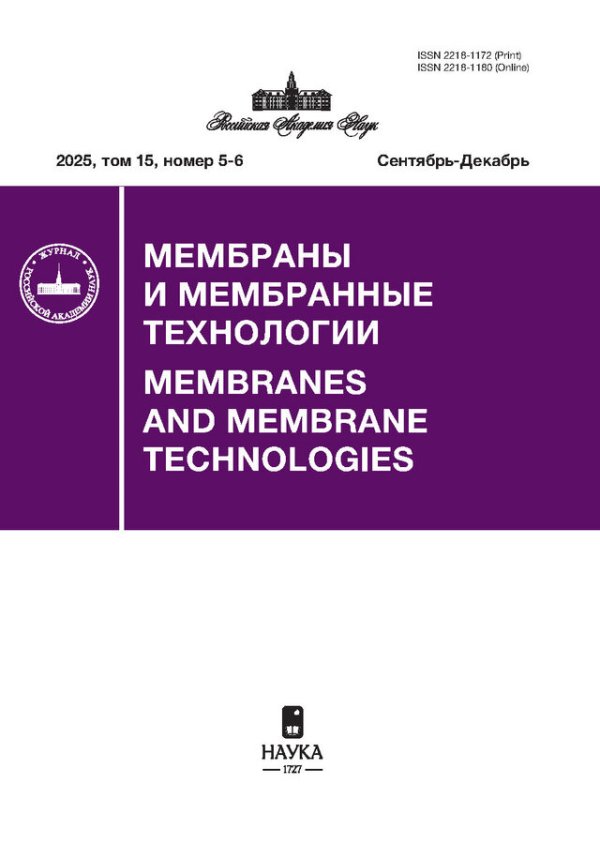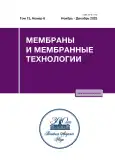Trifluoroethylacrylate-Substituted Polymethylsiloxane—Promising Membrane Material for Separating an Abe Fermentation Mixture
- Authors: Grushevenko Е.А.1, Rokhmanka Т.N.1, Balynin A.V.1, Golubev G.S.1, Borisov I.L.1
-
Affiliations:
- Topchiev Institute of Petrochemical Synthesis RAS
- Issue: Vol 13, No 6 (2023)
- Pages: 452-463
- Section: Articles
- URL: https://journals.rcsi.science/2218-1172/article/view/231876
- DOI: https://doi.org/10.31857/S2218117223060056
- EDN: https://elibrary.ru/HYLFVU
- ID: 231876
Cite item
Full Text
Abstract
This work is aimed at obtaining a membrane material that is resistant to the formation of a precipitate on the surface upon contact with an ABE fermentation mixture and has a good separating ability during the pervaporation isolation of n-butanol from a water–alcohol mixture. In this regard, in this work, for the first time, the creation of pervaporation membranes based on polymethyltrifluoroethylacrylatesiloxane (F3-Acr), as well as a copolymer of polydecylmethylsiloxane and polymethyltrifluoroethylacrylatesiloxane (C10-F3-Acr) is proposed. In comparison with polydecylmethylsiloxane (C10), the structure and sorption properties of the developed membrane materials for n-butanol, ethanol and acetone were studied. It should be noted that the highest sorption of n-butanol is characteristic of C10-F3-Acr (0.46 g/g). Changes in surface properties were assessed by the contact angle and elemental composition of the surface before and after exposure for 1 month in a fermentation medium. The transport and separating properties of the synthesized membrane materials were studied in the vacuum pervaporation mode during the separation of a model ABE fermentation mixture. It was shown that the introduction of a fluorine-containing substituent into the side chain of polysiloxane made it possible to increase the hydrophilicity of the polymer: the water flow for F3-Acr was 0.7 × 10–6 kg m m–2 h–1, which is almost 3 times higher than for C10. It is worth noting the positive effect of the combination of C10 and F3-Acr groups in polysiloxane. Thus, with an increase in the total flow by 60% compared to the C10 membrane, the values of the separation factor for n-butanol, acetone, and ethanol were 40.5, 32.7, and 4.3 and increased by 6, 15, and 12%, respectively, compared to the C10 membrane. For the C10-F3-Acr membrane, the pervaporation separation index for n-butanol, acetone, and ethanol was 136, 109, and 11. Therefore, this membrane is twice as efficient as C10. Taking into account the absence of detectable contamination of the surface of the membrane material with fermentation products, one can note the high potential of the C10-F3-Acr membrane for the task of isolating alcohols from the ABE fermentation mixture.
About the authors
Е. А. Grushevenko
Topchiev Institute of Petrochemical Synthesis RAS
Author for correspondence.
Email: evgrushevenko@ips.ac.ru
Russia, Moscow, Leninsky prospect, 29
Т. N. Rokhmanka
Topchiev Institute of Petrochemical Synthesis RAS
Email: evgrushevenko@ips.ac.ru
Russia, Moscow, Leninsky prospect, 29
A. V. Balynin
Topchiev Institute of Petrochemical Synthesis RAS
Email: evgrushevenko@ips.ac.ru
Russia, Moscow, Leninsky prospect, 29
G. S. Golubev
Topchiev Institute of Petrochemical Synthesis RAS
Email: evgrushevenko@ips.ac.ru
Russia, Moscow, Leninsky prospect, 29
I. L. Borisov
Topchiev Institute of Petrochemical Synthesis RAS
Email: evgrushevenko@ips.ac.ru
Russia, Moscow, Leninsky prospect, 29
References
- Zheng P., Li C., Wang N., Li J., An Q. // Chinese J. Chemical Engineering. 2019. V. 27. P. 1296–1306.
- Oh Y.K., Hwang K.R., Kim C., Kim J.R., Lee J.S. // Bioresource Technology. 2018. V. 257. P. 320–333.
- Dürre P. // J.: Healthcare Nutrition Technology. 2007. V. 2. P. 1525–1534.
- García V., Päkkilä J., Ojamo H., Muurinen E., Keiski R.L. // Renew. Sust. Energ. Rev. 2011. V. 15. P. 964–980.
- Green E.M. // Curr. Opin. Biotechnol. 2011. V. 22. P. 337–343
- Peralta-Yahya P.P., Keasling J.D. // Biotechnology J. 2010. V. 5. P. 147–162.
- Liu G., Wei W., Wu H., Dong X., Jiang M., Jin W. // J. Membrane Science. 2011. V. 373. P. 121–129.
- Kujawska A., Kujawski J., Bryjak M., Kujawski W. // Renewable and Sustainable Energy Reviews. 2015. V. 48. P. 648–661.
- Pulyalina A., Polotskaya G., Goikhman M., Podeshvo I., Chernitsa B., Kocherbitov V., Toikka A. // Scientific Reports. 2017. V. 7. P. 1–12.
- Van der Bruggen B., Luis P. // Curr. Op. in Chem Eng. 2014. V. 4. P. 47–53.
- Atlaskin A.A., Petukhov A.N., Yanbikov N.R., Salnikova M.E., Sergeeva M.S., Vorotyntsev V.M., Vorotyntsev I.V. // Chemical and Process Engineering. 2018. P. 323–333.
- Otvagina K.V., Penkova A.V., Dmitrenko M.E., Kuzminova A.I., Sazanova T.S., Vorotyntsev A.V., Vorotyntsev I.V. // Membranes. 2019. V. 9. P. 38.
- Liu G., Wei W., Jin W. // ACS Sustainable Chemistry & Engineering. 2014. V. 2. P. 546–560.
- Rozicka A., Niemistö J., Keiski R.L., Kujawski W. // J. Membrane Science. 2014. V. 453. P. 108–118.
- Rom A., Friedl A. // Separation and Purification Technology. 2016. V. 170. P. 40–48.
- Kujawska A., Knozowska K., Kujawa J., Li G., Kujawski W. // Separation and Purification Technology. 2020. V. 234. P. 116092.
- Борисов И.Л., Ушаков Н.В., Волков В.В., Финкельштейн Е.Ш. // Нефтехимия. 2016. Т. 56. № 6. С. 578–583.
- Bennett M., Brisdon B.J., England R., Field R.W. // J. Membrane Science. 1997. V. 137. № 1–2. P. 63–88.
- Грушевенко Е.А., Подтынников И.А., Борисов И.Л. // Журн. прикладной химии. 2019. Т. 92. № 11. С. 1488–1496.
- Borisov I., Podtynnikov I., Grushevenko E., Scharova O., Anokhina T., Makaev S., Volkov A., Volkov V. // Polymers. 2020. V. 12. P. 1213.
- Penkova A.V., Acquah S.F., Sokolova M.P., Dmitrenko M.E., Toikka A.M. Polyvinyl alcohol membranes modified by low-hydroxylated fullerenol C60 (OH) 12 // J. Membr. Sci. 2015. V. 491. P. 22–27.
- Polotskaya G.A., Pulyalina A.Y., Rostovtseva V.A., Toikka A.M., Saprykina N.N., Vinogradova L.V. // Polymer International. 2016. V. 65. P. 407–414.
- Jia Z., Wu G. Metal-organic frameworks based mixed matrix membranes for pervaporation, Microporous and Mesoporous Materials. 2016. V. 235. P. 151–159.
- Liu G., Chernikova V., Liu Y., Zhang K., Belmabkhout Y., Shekhah O., Zhang C., Yi S., Eddaoudi M., Koros W.J. // Nature Materials. 2018. V. 17. P. 283–289.
- Апель П.Ю., Велизаров С., Волков А.В., Елисеева Т.В., Никоненко В.В., Паршина А.В., Письменская Н.Д., Попов К.И., Ярославцев А.Б. // Мембраны и мембранные технологии. 2022. Т. 12. № 2. С. 81–106.
- Volkov V., Borisov I., Golubev G., Vasilevsky V., Matveev D., Bondarenko G., Volkov A. // J. Chemical Technology & Biotechnology. 2020. V. 9. № 1. P. 40–51.
- Fadeev A.G., Meagher M.M., Kelley S.S., Volkov V.V. // J. Membrane Science. 2000. V. 173. P. 133–144.
- Qureshi N., Blaschek H.P. // Biotechnology Progress. 1999. V. 15. P. 594–602.
- Rokhmanka T.N., Grushevenko E.A., Arapova O.V., Bondarenko G.N., Golubev G.S., Borisov I.L., Volkov A.V. // Applied Sciences. 2023. V. 13. № 6. P. 3827.
- Knozowska K., Kujawska A., Kujawa J., Kujawski W., Bryjak M., Chrzanowska E., Kujawski J.K. // Separation and Purification Technology. 2017. V. 188. P. 512–522.
- Yakovlev A.V., Shalygin M.G., Matson S.M., Khotimskiy V.S., Teplyakov V.V. // J. Membr. Sci. 2013. V. 434. P. 99–105.
- Шалыгин М.Г., Козлова А.А., Тепляков В.В. // Мембраны и мембранные технологии. 2022. Т. 22. № 4. С. 294–304.
- Chu Z., Seeger S. // Chem. Soc. Rev. 2014. V. 43. P. 2784–2798.
- Tuteja A., Choi W., Ma M., Mabry J.M., Mazzella S.A., Rutledge G.C., McKinley G.H., Cohen R.E. // Science. 2007. V. 308. P. 1618–1622.
- Lu X., Peng Y., Ge L., Lin R., Zhu Z., Liu S. // J. Membr. Sci. 2016. V. 505. P. 61–69.
- Zheng R., Chen Y., Wang J., Song J., Li X.-M., He T. // J. Membr. Sci. 2018. V. 555. P. 197–205.
- Zhu H., Li X., Pan Y., Liu G., Wu H., Jiang M., Jin W. Fluorinated PDMS Membrane with Anti-biofouling Property for in-situ Biobutanol Recovery from Fermentation-Pervaporation Coupled Process // J. Membr. Sci. 2020. V. 609. P. 118225.
- Borisov I.L., Grushevenko E.A., Anokhina T.S., Bakhtin D.S., Levin I.S., Bondarenko G.N., Volkov V.V., Volkov A.V. // Materials Today Chemistry. 2021. V. 22. P. 100598.
- Darvishmanesh S., Degrève J., Van der Bruggen B. // Chem. Eng. Sci. 2009. V. 64. № 17. P. 3914.
- Юшкин А.А., Анохина Т.С., Баженов С.Д., Борисов И.Л., Budd P.M., Волков А.В. // Мембраны и мембранные технологии. 2018. Т. 8. № 6. С. 434–439.
- Kang N., Du Z., Li H., Zhang C. // J. Appl. Polym. Sci. 2011. V. 124. P. 4915–4919.
- Stern S.A., Shah V.M., Hardy B.J. // J. polymer science part B: Polymer physics. 1987. V. 25. № 6. P. 1263–1298.
Supplementary files














